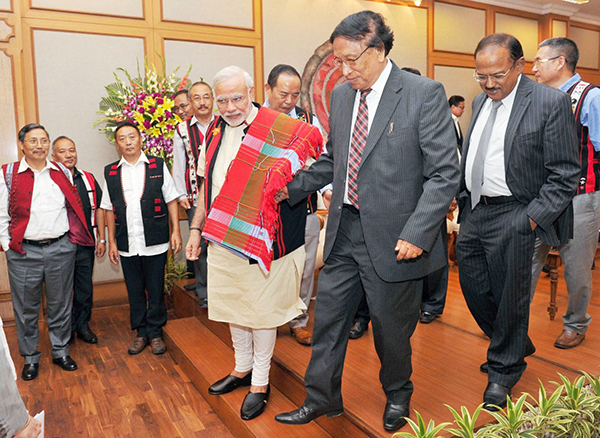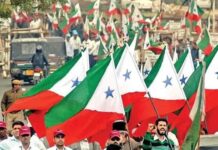
The Nagaland Governor’s letter in June addressed to Chief Minister Neiphiu Rio, alleging the collapse of law and order and that armed gangs “who question the sovereignty and integrity of the nation” were engaging in “blatant extortion”, touched a sore spot for the NSCN (I-M). While the group defended the practice by terming it “tax collection”, the letter was not entirely off the mark. Yet, this has become an issue for the peace process with the NSCN (I-M).
The NSCN (I-M) has demanded that Nagaland Governor R.N. Ravi should be removed as the interlocutor for talks on the Naga accord.
While the other Naga groups also took exception to the Governor’s remarks to the Chief Minister, they have differed with the NSCN (I-M) on the demand for Mr. Ravi’s removal as interlocutor.
Miffed, the National Socialist Council of Nagaland (Isak-Muivah), on 10 August, for the first time released the details of the 2015 Framework agreement amid peace negotiations in New Delhi. The framework agreement, which was signed in presence of Prime Minister Narendra Modi, came after over 80 rounds of negotiations spanning 18 years, with the first breakthrough made in 1997 when the ceasefire agreement was sealed after decades of insurgency in Nagaland which started soon after India”s Independence in 1947.
After skipping a meeting in Kohima convened by Governor R N Ravi, who is also the interlocutor in the Naga peace talks, the group is directly sitting with the Centre to salvage the decade-old dialogues.
Requesting for a new interlocutor, NSCN (IM) has faulted Governor Ravi for deleting a crucial word from the original framework and circulating a modified framework with other groups. The agreement released by NSCN (IM) stated that along with sovereign power-sharing, an “enduring inclusive new relationship of peaceful co-existence of the two entities” will be provided. Governor Ravi has, in turn, dropped the word “new” while sharing the framework with other umbrella groups like Naga National Political Groups (NNPGs).
ALSO READ NEIGHBOURHOOD: China May Foment Trouble in the North-East
Issues Involved
First, the trust deficit against the Nagaland governor as an interlocutor. The new revelation by NSCN (IM) has widened the existing mistrust against Governor Ravi. In the past, peace talks between NSCN (IM) and Governor Ravi had concluded in a stalemate over the demand for a separate constitution and flag. Since then the governor has come down heavily on the extortion trails of NSCN (IM) and also pressurized the government department for details on those involved with different groups. This has irked groups like NNPGs, who has been critical of the governor’s lack of empathy towards diverse interests in the process. The publication of the framework echoes a common sentiment amongst groups who had so far cooperated with the Centre that the governor is using a deal to force a consensus in the peace process.
Second, the declining popularity of the NSCN(IM). The ongoing NSCN (IM) ‘s talks with the Centre follows a time when the group is facing resistance on its ability to represent the collective Naga identity. Even though NSCN (IM) continues to be the largest group championing the nationalist cause, it still has not been able to balance out concerns on its overpowering Tangkhul character. Since the death of Isak Swu and Muivah’s deteriorating health, the group has been deemed as Tangkhul centric in its decision-making by the larger Nagas in Nagaland. The top leaders of NSCN (IM) had in the past decided against disclosing the 2015 framework, thereby giving in to the fears of a peace process being dominated by one tribe. Hence as the group looks to enter the political process and represent the larger Naga identity, its acceptance in the state will depend on how it holds its end in the peace talks with the Centre.
Third, long-drawn peace processes in the Northeast with no resolution. The peace processes in the Northeast have become less about peace, and more a strategy aligning with the development and security-centric approach of the central government. On the one hand, the Centre sits in the negotiating table ironing out the issues and on the other adopts a strong policing to keep insurgency in check. The fear of the return of insurgency has become imminent as the peace talks end in stalemate. Similar has been the fate of the Naga peace process structured around the NSCN (IM). It has been failing as the group’s acceptance in Nagaland, and Manipur shrinks and the ailing old leaders continue to lead the peace process alienating the youth in the cadre-based group. The current government has, in turn, lost patience and made the process transactional with ignorance towards the emotive nature of the Naga identity assertion.
ALSO READ China supplying weapons to terror groups in Myanmar – Indian Military Review
Comments
Five years since the signing of a framework agreement between the Indian government and the National Socialist Council of Nagalim (Isak-Muivah), the deadlock in the talks that came about in October 2019 persists with the emergence of bottlenecks.
differences between the NNPGs and the NSCN (I-M) are not insignificant. The NSCN (I-M) still insists on a “Greater Nagalim” beyond the boundaries of Nagaland State besides seeking a flag and constitution. Most of the NNPGs based in Nagaland on the other hand have sought to settle the issue without disturbing the State boundaries while keeping the “Greater Nagalim” question in abeyance. Any moves to alter boundaries will intensify ethnic conflicts and insurgencies beyond Nagaland, especially in Manipur. The increasing support in Nagaland for a solution without affecting boundaries should have compelled the NSCN (I-M) to move away from its intransigent position. Instead, the rebel group has sought to redefine the talks process by expressing its lack of confidence in Mr. Ravi.
Replacing the governor is not the solution but imperative and will put the talks back to square one. The approach of ‘What’s in a word’ has costed the interlocutor as he fails to heed the emotive and political significance of the framework. The Naga peace process needs a strong interlocutor who represents the region. As the Centre looks for a September resolution it is important to remember signing the final peace deal is not the end but only the beginning of a larger political process towards inclusion.
The peace talks between the NSCN (IM) and the Centre raise faint hopes of a peace agreement, but the sovereign nature of the group’s demands will further delay the process unless a middle path is achieved.

















